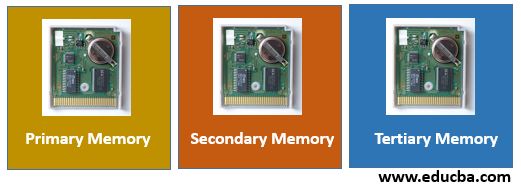Updated July 6, 2023

Introduction to Data Storage in Database
Data Storage system can be explained as the capacity secured by the database management system in the memory of the server allocated for the database and the related operations. There is also a term known as ‘Database Quota’ used for indicating the data storage units, which can be defined as a fraction allocated for each database system from the total limit set for the complete database management system. In a relational database type, the data storage is usually in the form of tables, columns, rows, and their corresponding relationships. In other words, it is normally a structured system arranged in a way to allocate the required space for the contents and operations of the database.
Types of Data Storage in Database
Typically, the Data in a Database is stored in the form of records, while in terms of devices the data are placed in the electromagnetic devices. The classification of these electromagnetic devices used for data storage in the database systems are as follows.
1. Primary Memory
Primary Memory can be defined as the type of data storage system that allows the central processing unit of a server to access it straight-up, without the help of any other devices. In general, for a primary memory to function without any glitches, it is necessary for it to have constant and uninterrupted resource contribution, such as the electric power supply, electronic hardware backup, continuous functioning of the supporting devices, coolant to moderate the system temperature, etc. These types of devices are identified to be considerably slighter in size and are volatile in nature. With respect to the performance and speed, the primary memory devices are the fastest devices, and this feature is indirectly proportional to the overall capacity of the devices.
A few of the commonly used primary devices for data storage in the database management systems are the CPU’s main memory, the CPU’s registers and otherwise known as the internal memory and the cache memory of the server that is accessible to the CPU for an uninterrupted data flow. All these memory units of the CPU will align with one another in order to fill in the disparity amongst the device capability. For Instance, whenever the CPU’s main memory is put to use, the cache memory is utilized alongside as well. This is because the CPU functions much faster than the main memory, where the cache memory aids in compensating the difference between the performances of both these devices.
Due to the increased speed and performance, the price ranges of these are the type of primary memory devices are usually higher than the other two types of storage memories.
2. Secondary Memory
Secondary Data storage devices, as the name says, are the devices which can be accessed for storing data that are required for a later point in time for various operations or database actions. Hence, sometimes these types of storage systems are called as the backup units as well. This memory category includes the devices that are connected or plugged in externally, unlike the primary memory that is observed to be the parts of the CPU. This group of the device are known to be noticeably larger in size than the primary memory units and smaller than the tertiary devices. It is also considered to be a temporary storage system, as it can hold data when the user needs and it can be deleted when the user is complete. In provision to the actions and the pace, these secondary storage devices are slower than the primary devices as well as faster than the tertiary devices. The capacity of the device is usually higher than the primary storage systems, but it gets evolving while the technological world is expanding day by day.
The commonly used secondary storage systems are the magnetic disks and optical disks such as the DVD or CD which were used in the olden days. In recent days, there are modern devices introduced by the constructive growth in technology, in order to provide more convenience for the users to handle multiple devices. These modern secondary storage devices include the portable and reusable hard disks, the flash drives that can be accessed in the form of plug and play via a USB port of the peripheral devices, etc.
RAID or the Redundant Array of Independent Disks is a concept of joining the essential secondary memory storage devices so as to fulfill one device’s shortcomings through another device in the chain. It uses processes like array data arrangement for structuring, the mirroring method, the error correction codes, isolating the single disk into multiple disks, etc. for the data to flow through successfully. The levels of RAID can be termed as RAID 0, RAID 1, RAID 2, and so on. These levels are planned and determined with respect to the intensity of the redundancy observed in the data that is stored.
3. Tertiary Memory
Tertiary Memory for data storage can be defined as the type of devices that are used for holding massive amounts and are not required to be connected to the server or the peripheral devices all the time. This type of device is connected from the outside to either the server or the corresponding device where the database is placed. As the tertiary storage can provide more space than other types of device memory but also the slowest of all the other device form, the cost is lower than the primary and secondary storage memories. This data storage is a commonly used one for making copies from the servers and database, as an attempt to make a backup of the data. Similar to the secondary devices, tertiary devices also allow the user to utilize the memory whenever required and to delete the contents when not required.
Conclusion
In a Database management system, the Data Storage is an essential feature that requires intense analysis and weighing in on various parameters in turn to choose a type amongst the three categories of Memory types. The Data Storage systems should be flexible enough to function alongside the server, the connected nodes and allow the database admin/ users to operate on the database independently.
Recommended Articles
This is a guide to Data Storage in Database. Here we discuss the Introduction to Data Storage in Database and its different types like Primary Memory, Secondary Memory, etc. You can also go through our suggested articles to learn more-

